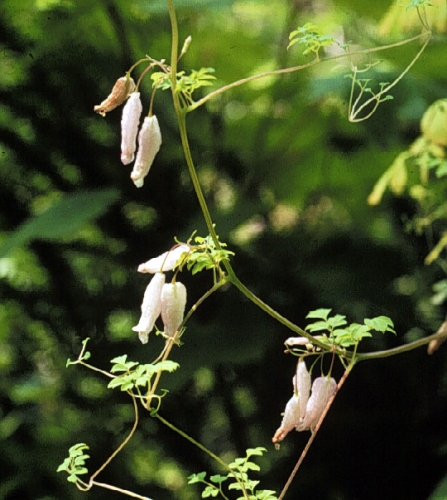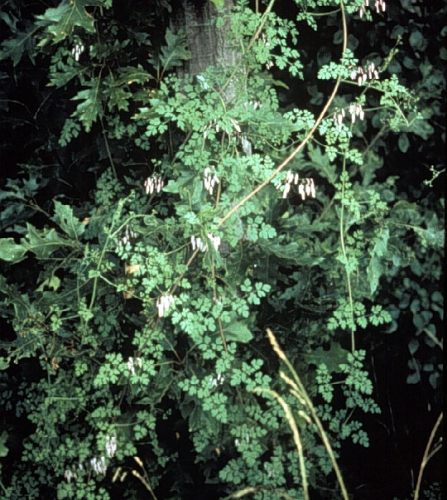Plants and Animals
Adlumia fungosa Climbing fumitory
Key Characteristics
Herbaceous biennial vine; leaves repeatedly pinnately compound; flowers pink, hanging from axils of leaves.
Status and Rank
US Status: No Status/Not Listed
State Status: T - Threatened (legally protected)
Global Rank: G4 - Apparently secure
State Rank: S3 - Vulnerable
Occurrences
| County | Number of Occurrences | Year Last Observed |
|---|---|---|
| Allegan | 1 | 1889 |
| Alpena | 2 | 2021 |
| Berrien | 3 | 2010 |
| Charlevoix | 1 | 1966 |
| Chippewa | 2 | 1958 |
| Delta | 5 | 2021 |
| Houghton | 1 | 1840 |
| Huron | 1 | 1911 |
| Kent | 1 | 1889 |
| Leelanau | 1 | 1989 |
| Lenawee | 1 | 1867 |
| Mackinac | 4 | 2014 |
| Marquette | 1 | 1960 |
| Menominee | 1 | 1892 |
| Ontonagon | 1 | 1939 |
| Ottawa | 1 | 1871 |
| Presque Isle | 2 | 1989 |
| Sanilac | 1 | 1915 |
| Van Buren | 1 | 1880 |
| Washtenaw | 1 | 1984 |
| Wayne | 1 | 1929 |
Information is summarized from MNFI's database of rare species and community occurrences. Data may not reflect true distribution since much of the state has not been thoroughly surveyed.
Habitat
Occurs in gravelly or rocky Great Lakes shores, woods, thickets, glades, mesic southern forests and in dune complexes.
Natural Community Types
- Dry-mesic southern forest
- Granite bedrock glade
- Limestone bedrock glade
- Limestone bedrock lakeshore
- Limestone cliff
- Limestone cobble shore
- Limestone lakeshore cliff
- Mesic northern forest
- Mesic southern forest
- Northern bald
- Northern hardwood swamp
- Open dunes
- Sand and gravel beach
- Volcanic bedrock glade
For each species, lists of natural communities were derived from review of the nearly 6,500 element occurrences in the MNFI database, in addition to herbarium label data for some taxa. In most cases, at least one specimen record exists for each listed natural community. For certain taxa, especially poorly collected or extirpated species of prairie and savanna habitats, natural community lists were derived from inferences from collection sites and habitat preferences in immediately adjacent states (particularly Indiana and Illinois). Natural communities are not listed for those species documented only from altered or ruderal habitats in Michigan, especially for taxa that occur in a variety of habitats outside of the state.
Natural communities are not listed in order of frequency of occurrence, but are rather derived from the full set of natural communities, organized by Ecological Group. In many cases, the general habitat descriptions should provide greater clarity and direction to the surveyor. In future versions of the Rare Species Explorer, we hope to incorporate natural community fidelity ranks for each taxon.
Associated Plants
Beech, sugar maple, basswood, tulip poplar, white ash, bitternut hickory, wild leek, ginger, cut-leaved toothwort, dutchman's breeches, yellow trout lily, Virginia waterleaf, false rue anemone, woodland phlox, herb-robert, common trillium, ginseng, goldenseal, hemlock, spotted wintergreen, bracted orchid, ticklegrass, yarrow, bearberry, marsh bellflower, pale Indian paintbrush, hair grass, spike-rush, butterwort, ninebark, silverweed, dwarf Canadian primrose, and wild rose.
Management Recommendations
This species requires soil disturbance. Where found along shorelines, protection of habitat and perpetuation of natural disturbance (winter ice, storms, wind) and long-term hydrological regimes is beneficial. Where found in inland mesic forests, a moderate amount of disturbance is likely tolerable, but large scale clear cutting is not recommended.
Survey Methods
Random meander search covers areas that appear likely to have rare taxa, based on habitat and the judgment of the investigator.
References
Survey References
- Elzinga, C.L., D.W. Salzer, and J.W. Willoughby. 1998. Measuring and Monitoring Plant Populations. The Nature Conservancy and Bureau of Land Management, Denver. BLM Technical Reference 1730-1. 477pp.
- Goff, G.F., G.A. Dawson, and J.J. Rochow. 1982. Site examination for Threatened and Endangered plant species. Environmental Management 6(4): 307-316
- Nelson, J.R. 1984. Rare Plant Field Survey Guidelines. In: J.P. Smith and R. York. Inventory of rare and endangered vascular plants of California. 3rd Ed. California Native Plant Society, Berkeley. 174pp.
- Nelson, J.R. 1986. Rare Plant Surveys: Techniques For Impact Assessment. Natural Areas Journal 5(3):18-30.
- Nelson, J.R. 1987. Rare Plant Surveys: Techniques for Impact Assessment. In: Conservation and management of rare and endangered plants. Ed. T.S. Elias. California Native Plant Society, Sacramento. 8pp.
Technical References
- Flora of North America Editorial Committee. 1997. Flora of North America, North of Mexico. Volume 3: Magnoliophyta: Magnoliidae and Hamamelidae. Oxford University Press, New York. 590pp.
- Gleason, H. A., and A. Cronquist. 1991. Manual of Vascular Plants of Northeastern United States and Adjacent Canada. 2nd Ed. The New York Botanical Garden, New York, New York.
- Holmgren, N.H. 1998. Illustrated Companion to Gleason and Cronquist's Manual. Illustrations of the vascular plants of Northeastern United States and adjacent Canada. New York Botanical Garden, Bronx. 937pp.
- Rabeler, R.K. 1998. Gleason's Plants of Michigan, a Field Guide. Revised edition. Oak Leaf Press, Ann Arbor. 398pp.
- Voss, E. G. 1985. Michigan Flora. Part II. Dicots (Saururaceae-Cornaceae). Bulletin of the Cranbrook Institute of Science and University of Michigan Herbarium. 724pp.



